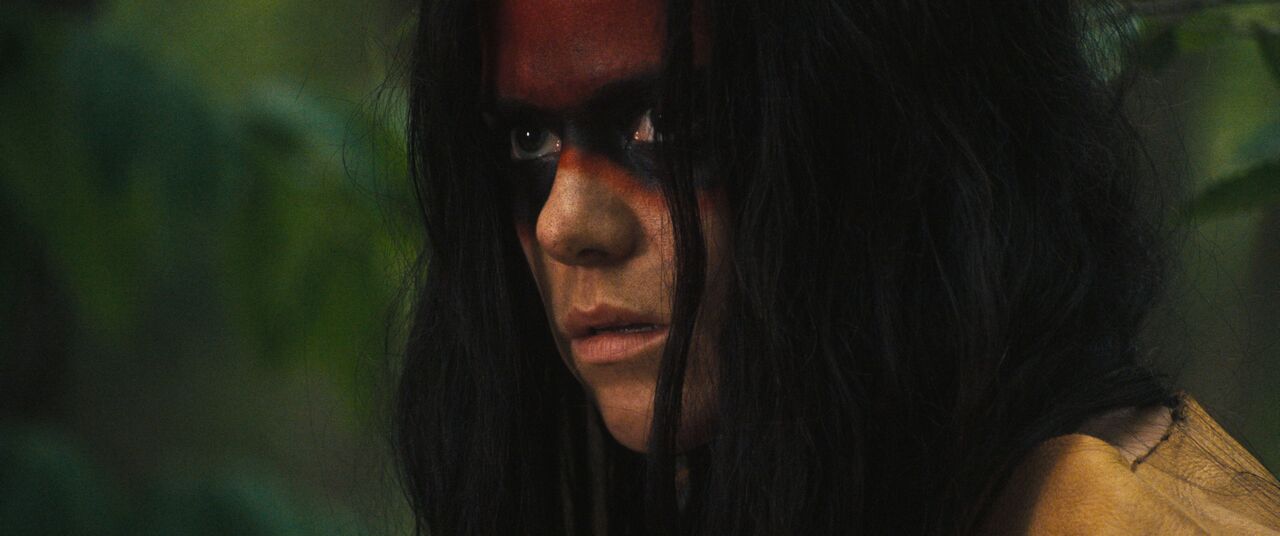MOVIE REVIEW: Mohawk
MOHAWK-- 4 STARS
Canadian fantasy author Kelley Armstrong once wrote a few biting lines about the idea of a chase in her novella Belonging. They read “...adrenaline pumped through me, like liquid fire. There was nothing quite like a chase, and one that ended with this reward was the best chase of all.” The singe of her words supremely could be lifted to describe the new thriller Mohawk because, by golly, who doesn’t love a good chase. The sophomore feature from filmmaker Ted Geoghegan proves big budgets are far from necessary to produce thrilling heat and an aura of tenacity.
Mohawk is set in colonial New York in 1814 during the second half of the War of 1812 between the young United States of America and the returning imperial British redcoats. An unending wave of land-grabbing and power-hungry Americans continue to infringe on Native American territories. Diplomacy is virtually ignored with the nearby war occupying all authority and attention and forcing groups to choose sides. Repeated skirmishes with the white men have decimated the Mohawk population. Any Mohawk justice in the form of violent reprisal for lives lost is commonly met with greater retaliation.
That’s exactly what occurs when the angry Calvin Two Rivers (Justin Rain of TV's Fear the Walking Dead) murders an emigrating group. His impulsive act paints a bullseye on his back and that his family. This includes his polyamorous companion Okwaho (Kaniehtiio Horn, an actress of true Mohawk descent recently seen in Death Wish) and her friendly British lover Joshua Pinsmail (Twin Peaks player Eamon Farren). They retreat deeper into the forest away from the American forts and settlements. On their tails is a company of American troops led by Colonel Charles Hawkes (Safe’s Jack Gwaltney) and the merciless Captain Hezekiah Holt (Ezra Buzzington of Fight Club). They are bolstered by the spectacled sharpshooter Sherwood Beal (Robert Longstreet of Take Shelter and last year's Sundance winner I Don’t Feel at Home in this World Anymore), the burly simpleton Private Lachlan Allsopp (Jonathan Huber, better known as WWE superstar Luke Harper), Holt’s weak braggart son Myles (Ian Colletti of Baby Mama), and the yellow-bellied translator Yancy (Looper’s Noah Segan).
Their maddening pursuit for prisoners takes the opponents into a rustic valley of Mohawk turf with a river bordering one side and the full war on the other. One by one, grizzly deaths dwindle numbers on both sides until the prophetic zinger line of “we’re the only monsters left out here” brings forth another plane of peril. The aggressive hunt turns ethereal and truly primal towards a crackling climax of mist and fire.
For a film this scale, the production values are downright stellar. The pulsations of electronic doom from composer Wojciech Golczewski (Beyond the Gates) strap you down from the opening credits onward. Golczewski’s work creates a dark atmosphere of simmering tension that spurs the kinetic energy with nary a jump scare chord trope in audible distance. The aural sharpness matches the visual edge as well. Director of photography Karim Hussain (Hobo with a Shotgun) employs an outstanding and complete use of natural light with a variety of handheld camera movements and stable framed setups that sponge up the imposing arboreal ambiance. His lens complements the raw production design work form veteran Steven Legler (Jeepers Creepers) utilizing the wooded environments and outdoor shooting locations, including the Skä•noñh Great Law of Peace Center in Syracuse.
Two secret weapons of Mohawk that show off smaller, but no less important, details are pair of debuting leaders and encouraging women in their longtime fields. Black Panther stunt performer and first-time feature coordinator Kimmy Suzuki brings the prerequisite punch and brawn to the action. Veteran makeup artist Ana Gabriela Quinonez (Point Break) heads the makeup department to vibrantly decorate the visceral scenes and characters with striking war paint and bleeding crimson. All of these production efforts start on the written page with a strong concept and keen sense of drive.
Writer/director Ted Geoghegan (We Are Still Here) and his debuting screenwriting partner Grady Hendrix map out a cavalcade of clashes that never waste a minute. Geoghegan has crafted taut pursuit thrills and cleverly staged fight sequences with the right touch of gore that never devolves into trivial nonsense. It would be easy for a developing filmmaker to craft something outrageously overblown to make one variety of attention-getting noise. The opposite is the case with Geoghegan. The best fire is one that burns long to turns its coals white, not one composed of all flame and flash.
LESSON #1: DON’T INCITE YOUR ENEMY-- Boy, does this go for both sides in this treacherous conflict. They’re either upsetting wild spirits or wronging God with any neutrality destroyed. If you cannot defeat the vengeance that is sure to come from your potential opponent, don’t set them off. Every brash step taken by these fighters only makes things worse and costs lives.
LESSON #2: TACTICS, TACTICS, TACTICS!-- Don’t mistake the crude era of the early 19th century for unintelligence. If Lesson #1 has been triggered and a fight is on, bring your top game. Be mindful of your surrounding arena. Hone your techniques. Consider the rules of engagement or the ways they will be broken. Measure the wavering neutrality of this war. Gauge risks. Chose action or inaction and, most of all, stick and move.
LESSON #3: WHO IS THE GREATER MONSTER?-- The further cinematic oxygenation from Geoghegan and Hendrix fueling Mohawk’s fire is its dialogue and supporting narrative laced with social and political commentary that dangles historical colonial parallels to the present. No quarter is given as to which demographic gets the allegorical compassion and which gets the skewer of villainous blame. The piercing provocation is spot-on and elevates the bold stakes of this film.
LOGO DESIGNED BY MEENTS ILLUSTRATED (#670)



